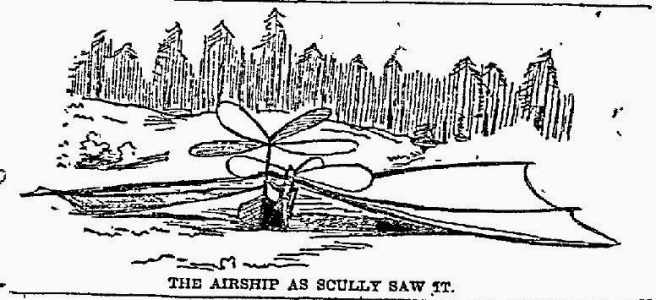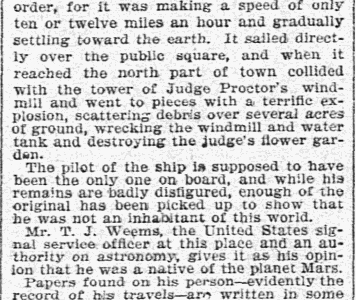Today, I share the next instalment from On the Phantom Air Ship Mystery, a retelling of the archetypal UFO crash in Aurora, Texas, 17 April 1897. Like the uncannily prophetic depiction of the alien abduction schema in the 1963 film The Haunted Palace, the story of the Aurora, Texas airship crash possesses many of the features of later, similar tales avant le lettre: the crash itself; the small, burnt body of its pilot; strange, heiroglyphic writing found on items in the wreckage; and the “burying” (metaphorically, the cover up) of the body and wreckage. However tall the tale (as Kevin Randle maintains), it is nevertheless canonical and haunts ufology to this day; Jacques Vallée and Paola Harris reference its similarities to the Trinity crash, the subject of their recent book, in all its versions…
Tag: Aurora UFO crash
RE: Medieval UFOs: footnotes for Swancer, Sprague & Hanks
I’m unsure what eddies in the aether are stirring up certain synchronicities, but last week (17 and 18 May 2020) Ryan Sprague with Micah Hanks spoke about Medieval UFOs and Brent Swancer posted a column on “strange accounts of very old UFO crashes”.
I listened through Sprague’s and Hank’s conversation and read Swancer’s column with some impatience, despite their many virtues, as the concerns they all address are interesting and, to use the word of the day, serious, but more complex, I’d argue, than they venture to unfold. For that reason, as a kind of Public Service Announcement, I point interested parties to posts here at Skunkworks that have grappled with some of the topics Sprague, Hanks, and Swancer touch on.
Sprague’s and Hanks’ conversation is wide-ranging and orbits in general the way or ways unusual aerial phenomena are variously interpreted over time, from antiquity to the present, the hermeneutics of which I essay here.
Around the 35:00 minute mark of Sprague’s and Hanks’ discussion, the subject of Medieval sky ships is broached, specifically one narrative of the chronicler Gervase of Tilbury, that Brent Swancer also addresses. It’s curious none remark the repetition of more-or-less the same story during the Airship wave of 1896-7. An any rate, I analyze the story, especially in its character as a story or narrative, here and here.
Sprague and Hanks also probe the question of artistic representations of what some have claimed are Flying Saucers, Extraterrestrials, or Visitors. This question is one I’ve harped on repeatedly here, of the problems around understanding narratives or artifacts from distant times and cultures. The briefest treatment, I think pretty much in line with Hanks’ views, is readable here.
Around the 59:00 minute mark, Sprague and Hanks conclude talking about nonmaterial modes of communication with so-called extraterrestrials, either by means of telepathy or altered states, a topic played with poetically, here. In fact, there are a number of poetic treatments of classic and not-so classic UFO reports (including the crash at Aurora, Texas Swancer includes in his article) throughout Skunkworks, accessible under the ‘poetry‘ category.
(Much) more, of course, could be appended. The curious will likely find posts to pique their respective interests wandering through the posts here….
Phantom Airship Crashes at Jefferson and Aurora
Since this year’s Solstice, Kevin Randle has been writing on the purported crash of an airship in Jefferson, Iowa in April 1897, providing a wealth of original material and even a photograph of an airship that landed in Waterloo, Iowa. He has gone on to contrast this story with that of the other, more famous, crash in Aurora, Texas the same month.
Randle concludes that both stories are hoaxes, perpetrated by the newspapers of the day to increase circulation. Of course, from the point of view of the mythos, what is important is that the waves of both 1897 and 1947 present with what Leonard Stringfield would term “Crash/Retrieval Syndrome”. Indeed, what is most valuable from a textual point of view is that, as Randle notes, the debris from the Aurora crash were dumped down the town’s well, which links the tale, at the level of the signifier, to that most famous crash/retrieval story, that of Roswell, i.e. Rose-well, a name that will bring to the minds of some readers the expression “sub rosa“…. ‘Aurora’, too, is a more suggestive name than ‘Jefferson’ in this context, as well.
For these. and other very likely contingent, reasons, my initial poetic treatment of the Phantom Airship Mystery includes the crash at Aurora, which I include below:
17 April: Aurora
The railroad passed
An epidemic just
The West Side burned down
Weevils got the cotton
*
One came in from the north low over Wise County with the sun
Ten twelve miles an hour dropping toward the ground
Clear over the square right at Judge Proctor’s windmill
Three miles away they saw the flash and explosion
Fragments over three acres east and northeast
Windmill and watertank wrecked
flowerbeds ruined
What remained of a small man disfigured past human resemblance
And his hieroglyphic log penned in violet
Together were buried in the cemetery that day
*
I was in school that day and nothing happened
He saw the air ship when it swung in low to crash
They wouldn’t let me see it but told me all about it
They went to the crash and saw the wreckage and torn-up body
I heard about it all my life
It passed like any other story
In the Masonic Cemetery no unmarked graves
Never was a windmill at the Judge’s
Tons of metal found by the son down the well years later



